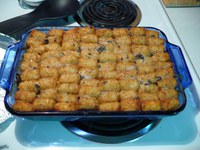Prairie Fare: Do You Know the 3 R’s of Kitchen Conservation?
(Click the image below to view a high-resolution image that can be downloaded)
By Julie Garden-Robinson, Food and Nutrition Specialist
NDSU Extension Service
“Mom, do you know how long that plastic jug will last in the landfill?” my 11-year-old daughter asked me.
“No, I don’t know.” I replied.
I had a feeling I was inviting a lecture on recycling. She pulled a handout out of her backpack and began reciting how long various containers last. I knew we would need to recycle the piece of paper, too.
Our conversation was a good reminder of the three R’s: reduce, reuse and recycle.
I felt a little guilty as I looked around our kitchen at the various items that seemingly last forever in the environment. I reminded her that we recycle cans, cardboard, newspapers and glass. I think she was not-so-gently reminding me it was time to take a load of items from our garage to the recycling bins.
The next day, I bought some laundry detergent. She grinned in approval when I picked up the “pouches” of detergent to refill the large plastic bottle we have at home.
After all, I now know that a plastic jug may last 1 million years in the environment.
I also bought a large bag of dog food instead of a smaller one, and we saved some money, too. We carried our items from the store in cloth bags that we brought from home.
I looked up some additional information for this article online. I will let my ecofriendly daughter know that I didn’t print any copies. I think she will be proud.
Public health entities have provided lists on the estimated length of time items last in the environment. For example, a banana will decompose in three to four weeks, a paper bag will break down in a month and a soup can will last up to 100 years. A soda pop can may last up to 500 years, and Styrofoam containers may last forever in the environment.
We can reduce waste in many ways in our kitchen and potentially save some money in the process. When you are wondering what’s for dinner, check what you have on hand in your cupboards, refrigerator or freezer. Using food while it is still in its “prime” can help prevent waste.
For example, the other day, I noticed I had frozen ground beef, two bags of half-used frozen mixed vegetables and some frozen Tater Tots. All I needed to buy was mushroom soup and we enjoyed that upper Midwest delicacy, Tater Tot hotdish. I had cleared valuable real estate in our freezer. I also recycled the can.
What are some ways we can reduce waste? These are some ideas to consider.
- Buy refills for dish detergent or hand soap to fill the containers you have.
- Use a reusable lunch bag if you bring your lunch to work.
- Use cloth grocery bags instead of plastic. Recycle plastic bags or use them for other purposes.
- If you are frequent coffee consumer, you might want to purchase a refillable cup instead of getting a disposable one. Be sure to wash your cup, though.
- Whenever possible, use washable plates and cups instead of paper or Styrofoam. Yes, the washable ones require water and electricity. If you have a dishwasher, run it when it is full and use the most conservative settings in terms of water use.
- Use disposable items for other purposes. A glass jar or plastic container can become storage containers for various items.
Have you shopped your freezer and pantry lately for a dinner meal? How about some good, old-fashioned Tater Tot hotdish? You can find many variations of this classic Midwest dish in cookbooks and online recipe sites, but this is close to the recipe that I grew up eating. It has just five ingredients.
Midwest Classic Tater Tot Hotdish
1 1/2 pounds lean ground beef
1 medium onion, chopped
1 (10.75-ounce) can cream of mushroom soup
1 (10-ounce) package frozen mixed vegetables (or your choice)
1 (16-ounce) package frozen Tater Tots (regular size, not the mini ones)
Preheat the oven to 350 F. Brown the ground beef and onion, then drain the fat. Spray the bottom of a 9- by 13-inch baking pan. Layer the browned beef and onion mixture, top with frozen vegetables. Spread the soup over the top of the meat and vegetables. Place a layer of Tater Tots on top. Bake for about one hour covered. Uncover and bake 15 minutes until it is bubbly and the Tater Tots are browned.
Makes eight servings. Each serving has 320 calories, 17 grams (g) of fat, 23 g of carbohydrate, 19 g of protein, 3 g of fiber and 590 milligrams of sodium. To reduce the sodium content, you can select reduced-sodium soup.
(Julie Garden-Robinson, Ph.D., R.D., L.R.D., is a North Dakota State University Extension Service food and nutrition specialist and professor in the Department of Health, Nutrition and Exercise Sciences.)
NDSU Agriculture Communication – Nov. 6, 2014
| Source: | Julie Garden-Robinson, (701) 231-7187, julie.garden-robinson@ndsu.edu |
|---|---|
| Editor: | Rich Mattern, (701) 231-6136, richard.mattern@ndsu.edu |


